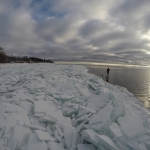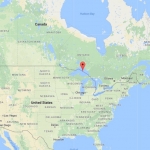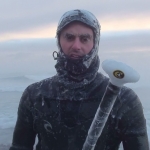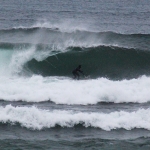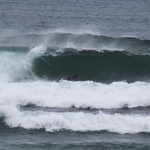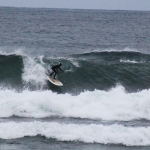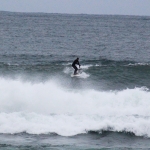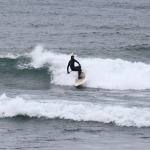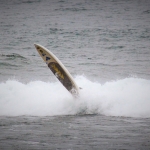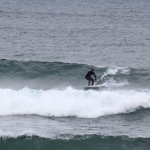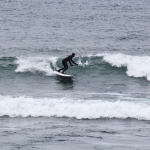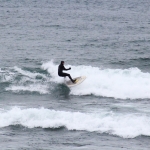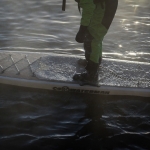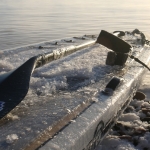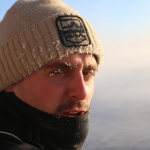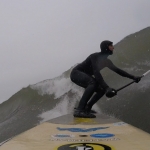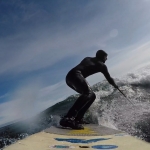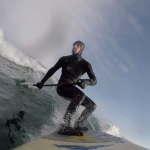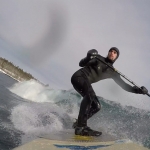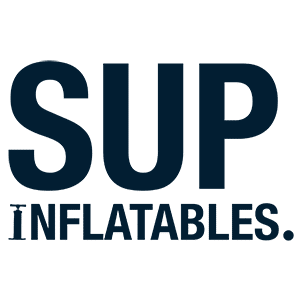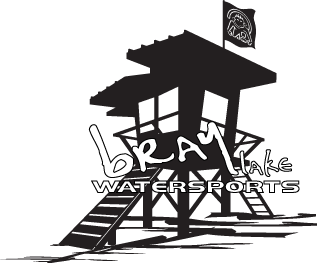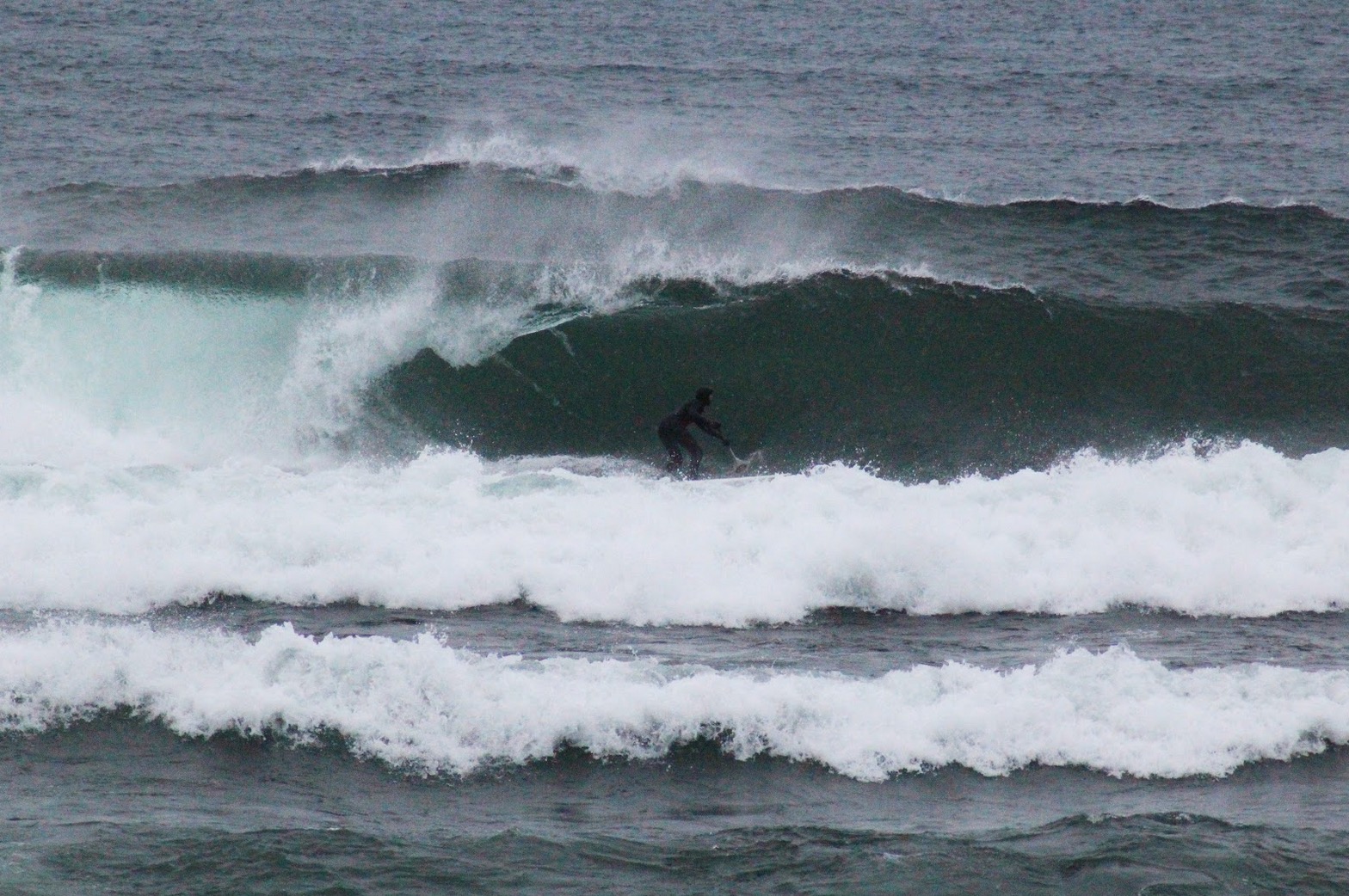
You know its cold when your paddle freezes and your feet stick to the deck! That’s whats involved if you want to surf the freshwater waves on Lake Superior in North America.
Not everyones idea of fun! But for Jared Munch who was born and raised in Northern Wisconsin it’s just the norm! From a young age Jared learned to love the cold and the outdoors, and soon became an action/adventure sports enthusiast growing up enjoying snowboarding, sking, mountain biking, skateboarding, kiteboarding, and whitewater kayaking. Whilst at college in Duluth, MN Jared got introduced to SUP, and went on to become a frequent paddler, SUP instructor and safety advocate of paddle sports.
Despite being many miles from the sea Jared soon discovered that there was plenty of fun and waves to be had on nearby Lake Superior. At more than 82 km² Lake Superior is the largest of the Great Lakes in North America and is an ideal place to SUP. The vast expanse of water provides miles of shoreline to explore flat water paddling, and during winter when the conditions are right surf can be found at numerous locations around the lake.
But SUP surfing freezing Lake Superior is not for everyone, and it takes a certain kind of (crazy!) person to get out there and do it! Jared shares his experience of lake surfing and explains what is really involved in SUP surfing a freshwater lake in minus temperatures!…
SB/When did you first discover SUP surfing on a lake?
I remember when I was probably 8 years old my dad was taking my brother and I up north on a fishing trip. As we drove past Lake Superior we saw people surfing and couldn’t believe it. I never really thought that I would be one of them until I got to college. What started as a whitewater canoe and kayak instructor position led me to learning how to paddle a SUP, which then trickled down to a desire to bring my board skills to the water. By the end of my junior year of college I had pieced together enough equipment to be a self contained Great Lakes surfer.
SB/How is it possible to have waves on a lake?!
Every lake is going to be different based on size and depth profile, but just like in the ocean, the waves are created by wind. Wind blows across the water, and waves are formed. What gives the great lakes the ability to build such big waves over shorter fetch distances is that a 0 degree air is much more dense than a tropical 80 degree air. Dense air is able to dig into the surface much more to build waves.
SB/What conditions do you need for surf on Lake Superior?
Lake Superior is the largest freshwater lake by surface area, and a northeast wind has a 300 mile fetch of open water to build waves before it hits my home breaks. Alternatively, a southwest wind will send waves to the other end. In general, any strong wind that can sustain for 24 hours across the lake is going to build up a solid ground swell and deliver waves somewhere.
SB/Tell us a bit more about surfing on Lake Superior. When does it work and how long for?
It only really works during the winter when there is cold, dense air blowing across the lake. It’s also generally more windy in the winter. How long there’s swell really depends on how long the storm lasts. It’s not terribly uncommon to have three days of surf in a row. The main season is in late fall through to spring, when the air is cold and there are sustained wind directions. Typically, on the southwest end of the lake there will be surf once a week. This winter has been slow, however.
SB/What’s the wave like on Lake Superior?
It varies. Usually during the storm it will be pretty choppy with tons of current.
“The wave height can easily reach 10 feet during the winter.”
Local buoys occasionally read over 15, and sometimes 20 feet. The intervals are short though, so you really have to be a strong paddler to get out in certain places. There are beach breaks, point breaks, and a few reef breaks. They all work in different conditions, and some more reliably than others. On a medium to small day most of the spots will be pretty mushy waves. On a bigger day the waves can have quite a bit of punch to them.
SB/Does your surf spot vary depending on conditions or is there only one spot that works on the lake?
There are lots of places. The spots all vary so much, and conditions change so quickly that it’s easy to spend a couple hours driving and checking everything out before you even get in the water. There aren’t really any webcams shooting over the breaks, so it can be an adventure just getting to the water.
SB/How different does a fresh water wave differ from a salt water wave?
My only saltwater surfing experience is in Hawaii and southern California, and it’s totally different. The combination of little buoyancy and wearing a thick suit in Lake Superior really wears you out quickly. In terms of wave riding, I don’t know. I’m honestly probably not good enough to be able to tell the difference. But I do know that since the conditions of lake surfing are so in your face, it’s a really different sensation than warm water ocean surfing.
SB/What gear do you need to get the most out of surfing Lake Superior?
Hooded 6/5 and 5/4 suits are top choice combined with 7mm mitts and booties. Having a heated vest underneath everything also helps on the really cold days. For just touring or downwinding I’ll usually wear a drysuit with base layers underneath.
Having a canteen of hot water can help revive a session by pouring the hot water into your booties and mitts to warm up the extremities. Since the conditions vary so greatly, having a couple of boards is a safe bet. I personally have a 7’6” funboard, a 6’8” big guy short board (I’m not big though) and a couple of SUP surf boards. Since the water is less bouyant than salt water, it’s nice to have a little extra volume underneath you. Most people use a bigger board than they would in the ocean. Having a reliable vehicle also helps a ton. I froze my butt off one time because my car battery died and I had to wait for someone to come pick me up after my session!
SB/Whats the local scene at Lake Superior and how big a crowd would you find on a busy day?
It depends on where you go around the lake. Some of the popular spots can get fairly busy on a good day. I usually like it when the air gets super cold, because it thins the crowds. It is easy to avoid a crow though if you are willing to explore and work for waves. There are lots of spots that most people don’t know about. Touring on a SUP really made me aware of this. A big day on the lake is well overhead. Usually on these days it will be really crowded at the most popular places, but thins quickly as the people that drove up from the cities quickly realise that they are in way over their head!
SB/What are the biggest challenges when lake surfing?
Lake Superior specifically creates a ton of current near shore – way more than I’ve experienced in the ocean. This happens because the surf really only happens during storms, with conditions that most ocean surfers probably wouldn’t even waste their time with. Another challenge lies in the conditions of the water itself. The surf is rarely clean. Paddling out and sitting (or standing) in a mess of chop to find a wave while fighting the current just to stay in position is a ton of work. I’d say the last, and largest challenge of lake surfing is the temperatures we face.
SB/What do you enjoy most about lake surfing?
In the back of my mind I’m always giggling that I’m surfing a lake! I think almost everyone out there feels the same way, because everyone is typically pretty stoked. Lake surfing is definitely not about charging on perfect waves, but more about the overall experience.
SB/What other lakes have you surfed around the world and where’s your favourite spot?
I’ve also surfed Lake Michigan and ridden downwind bumps on Lake Ontario. The most popular Lake Superior surf spot is Stoney Point, but my favourite spot is a wave north of stoney point, in a big bay that is protected from the wind, but has good long rides.
SB/What other lakes would you like to surf?
Well the options are pretty limited, being that there are very few lakes in the world capable of producing waves. I’d say I’m pretty content with where I’ve surfed now. Lake Superior is the biggest and can generate the best waves, so I’m pretty spoiled with it.
SB/Whats the coldest conditions you’ve paddled in?
Air: -20℉ (-28°C) Windchill: -35℉ (-37°C) Sea: 32℉ (0°C)
“I was watching ice form in sheets before my eyes and had a quarter inch of ice buildup on my deck!”
I was just out for a leisurely paddle that day. I’ve surfed in some seriously cold stuff before, but not quite that extreme.
SB/Why should someone have a go at SUP surfing on a lake?
Just to try something new. A lot of people think that lake surfing is fake, or is always terrible conditions. It actually can line up really well and be a ton of fun.
SB/What are the main challenges surfing in the extreme cold?
The bulk of thick neoprene really makes it difficult to paddle. It also reduces flexibility, especially when it starts getting covered in ice. Another really big challenge specific to SUP surfing in the cold is the ice buildup on the paddle. The ice makes the paddle so slippery that you lose almost all dexterity. The best way to deal with it is to hold the paddle underwater where it can’t freeze until you see your wave.
“On the coldest days you just barely have enough time to ride a wave before your paddle is too slippery to grip.”
The last major difficulty of the cold is the loss of feeling in the hands and feet that occurs occasionally, along with general shivering. It’s really hard to have a feeling of a board under your feet, or just stay composed in general. Those are just the big things though. All the small things that go into a day such as setting up a camera or going in to take a pee are also super hard to do in the cold. If someone can learn to surf well in the freezing cold on a lake, they can surf almost anywhere. When I go on surf trips to warm climates, it almost feels fake to me – like an amusement park.!That’s part of what makes going to new places so fun. It’s never going to be the same as what you are accustomed to.
SB/What are your 5 top tips to surviving SUP surfing in sub zero temperatures?
1. Find a 7mm mitt with a lot of grip on the palm to hold a paddle. 5mm gloves can also work if the temperature is just lingering around freezing.
2. Use a bigger board than normal. You will appreciate some stability when you loose feeling in your feet and your body is shivering. Also, the 7mm boots you will be wearing will reduce board feel from the beginning.
3. Be friendly. If you are rude, people won’t be so inclined to help you when your car gets stuck in the snow!
4. Bring hot water to pour down your suit for a quick warm up.
5. Eat well before, during, and after. If you bonk in the water, you will get very cold very quickly.
SB/Can you give us 5 top tips to lake surfing?
1. Be self aware of your body heat, and know when to go in.
2. For those who live around a lake and are stoked to give it a go – choose the right conditions to try in. A lot of people try for their first time during the middle of a storm and just get destroyed.
3. Have good neoprene and make sure it’s leak free.
4. Observe the locals. Since the conditions of lake surfing can be so hectic, there’s a reason that you might not see people at popular surf spots on some of the bigger days.
5. Be friendly. Nobody who surfs the lakes is pro, and probably won’t care if you are.
A great insight into lake SUP surfing, thanks Jared. Surfing at Lake Superior is definitely not for the faint hearted, but if you fancy a challenge and something a bit different this year then why not give it a go! Just don’t forget your extra neoprene, hot flask of water and snow shovel! Is there such a thing as de-icer for a wetsuit!? If so you might just need that too!
Have you ever surfed on a lake? If so we’d love to hear where and how you found it. Contact us via email here.
To watch Jared’s videos of SUPing Lake Superior click here.
